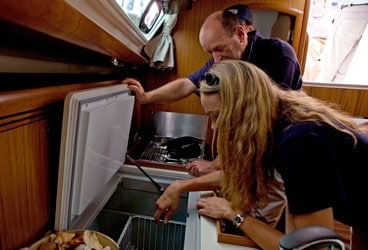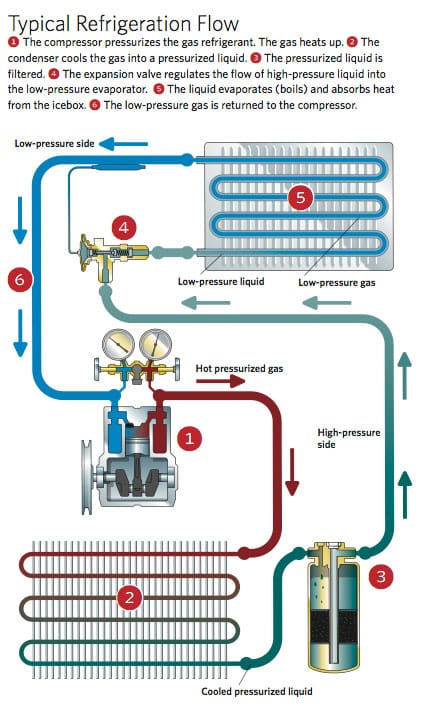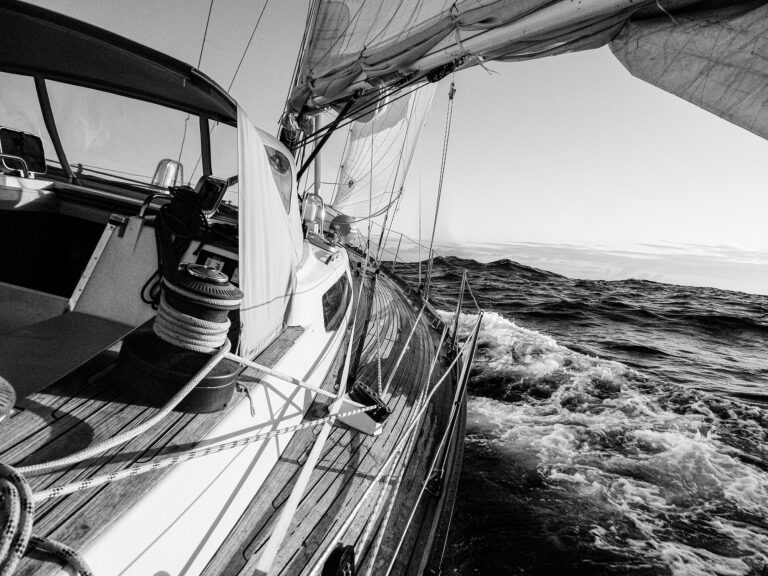
reefer madness 368
Anyone who’s ever been on a charter or an extended passage knows how important that little hole in the galley that keeps the food and beer cold is to happy cruising. So we’re going to dive in to see how that mysterious chilly box works and to explain the basics you need to know to choose the right system.
Since this is such an important and somewhat mystical subject, I called on my buddy Roger Hellyar-Brook to shed some light on the dark art of refrigeration. He’s an instructor in all aspects of systems and boatbuilding at the Landing School in Maine, and he was Cruising World’s systems-specific judge in last year’s Boat of the Year program. “Refrigeration is one of my favorite subjects,” he says. “It’s easy, really. A fridge is like a sponge.”
“Ahh, right,” I say. “I mean, huh?”
“A refrigeration system,” he says, speaking a little slower, “makes things cold by removing heat.”
“OK, now we’re on to something,” I say, furiously scribbling on my pad. That, I’d learn, was only the beginning of the basics.
How It Works
As Roger says, all marine refrigerators remove heat from a box. And all use a gas refrigerant that’s condensed (turned into a liquid) and evaporated (turned back into a gas) at different pressures in a closed system. The heat removal-which causes the icebox to get cold-happens when pressurized liquid refrigerant is allowed to quickly decompress in a long, curved tube in the icebox. The pressure drop in the system causes the liquid to evaporate, and as we all learned in high-school science class (OK, maybe some of us), when a liquid evaporates (boils off into a gas), it absorbs a significant amount of heat, at least enough to keep the beer cold.
All refrigeration systems have a high-pressure side and a low-pressure side (see illustration page 88). Heat is removed from the icebox on the low-pressure side, but the pressure must be first increased on the high-pressure side. To accomplish this, all marine refrigeration units are made up of the same four basic components: a compressor, a condenser, an expansion valve, and an evaporator.
The compressor does exactly what you’d think it does-it compresses the gas refrigerant. This pressurized gas then passes through a condenser, a long tube that acts somewhat like a radiator in your car. The condenser allows the temperature of the gas to drop to the point that the gas condenses into liquid. As the gas becomes a liquid, it releases heat.
At this stage, the refrigerant is a cool, pressurized liquid. The cold happens when this cool, pressurized liquid passes through the expansion valve into the evaporator in the icebox. The evaporator allows the pressure of the gas to drop significantly. The expansion valve is essential to control the high-pressure liquid passing into the low-pressure evaporator. The evaporator works on the opposite principle as the condenser: As the pressurized liquid passes into the evaporator, it evaporates-or vaporizes-into a gas. It’s like a radiator that absorbs rather than releases heat. As the liquid vaporizes in the evaporator, heat is removed (the temperature drops) from the icebox, and the beer gets cold. The last step in the cycle returns the decompressed refrigerant back to the compressor, and the whole process starts all over again.
Once Roger explained the basics, he moved right on to the choices.
A Constant-Cycle,DC-Powered System
A constant-cycling DC unit acts like the fridge you have at home, except it runs on DC rather than AC power. It’s controlled by a thermostat and turns on and off as often as necessary to keep the icebox at a set temperature. The temperature stays consistent throughout the entire box, and in some cases, these units can be installed by an average boat owner. They’re often equipped with air-cooled condensers and come sealed and pre-charged with refrigerant. Another benefit that anyone who’s fished a soggy, spoiled chicken breast out of the smelly water at the bottom of a simple icebox will appreciate: There’s no melting ice and, as a result, no smelly water.
On the other hand, some of the smaller constant-cycle units aren’t too powerful, and as you’d expect with something that’s constantly turning on and off, their daily power consumption-which can be as high as 20-50 amp-hours-is significant. However, most boats these days are equipped with the robust battery capacity and efficient charging capability to keep up with the increased energy demands. And since these systems draw low power over time instead of requiring higher power for shorter durations, they can be easier on the batteries than a cold-plate system (described next).
These units work great on a boat in a marina or on a weekend cruise within close range of shore power. And they’ll be up to the rigors of long-term, offshore cruising provided the boat has ample battery capacity. As with all electric-powered systems, running the engine will be required to keep the batteries charged, but in some cases, wind- and solar-powered chargers can come pretty close to keeping up with the energy demands of these units.
A Cold-Plate-Equipped, DC-Powered System
Instead of keeping the box cool by constantly cycling on and off, these refrigeration systems freeze a small tank-the cold plate-in the fridge itself. The unit runs until the cold plate is frozen or the fridge reaches a certain thermostat-controlled temperature; then it shuts off. The frozen plate then keeps things cold just like a block of ice.
The obvious benefit of this system is that it cycles on only when the cold plate thaws below a certain temperature, and only for as long as it takes to refreeze the plate. As a result, running these systems for 1 to 2 hours per day is often all you need to keep the batteries charged and the fridge cold.
These systems put significant loads on the batteries and usually require running the engine to keep the batteries charged when the fridge is on. But you don’t need to run the engine at all as long as you’re keeping your batteries topped up with shore power at the dock in the marina.
Of course, since these systems are essentially keeping the box cold with a block of ice, the food that’s kept near the frozen cold plate will be real cold, and the food that’s not as close won’t be as cold. And just as with a block of ice, as the cold plate thaws, water can collect at the bottom of the box. You’ve got to keep it pumped out to avoid the soggy/smelly chicken-breast problem.
An Engine-Driven System
With all this talk of having to run the engine to keep the batteries sufficiently charged to operate both types of DC refrigeration systems, why not power the compressor by adding a drive belt to a pulley on your boat’s engine? Good question. The answer: The engine must always be running at more than idle speed to run the reefer. If you’re at sea or don’t mind running the engine, it’s no big deal, but who wants to run the engine every day to keep the reefer cold in a marina? Engine-driven units are generally more powerful than constant-cycling DC units. They’re comparable in cost to a DC cold-plate unit, but in practice, you get more flexibility with the DC unit. The engine doesn’t have to be running to power the fridge when hooked up to shore power in a marina with a DC unit, and you can still be self-sufficient-recharge the batteries with the engine-when you’re on the hook or at sea for extended periods.
For those who like redundancy in their systems, it’s possible to get a DC/engine-driven system. “If you want the Cadillac of refrigeration systems, I’d go with a dual DC/engine-driven unit,” says Roger. “But it’ll cost ya.”
An AC-Powered System
Big sailboats with AC generators running all the time have plenty of power to run-and benefit from-a constantly cycling refrigerator/freezer similar to one that you’d find on land. But your average cruising boat just doesn’t have that kind of power. An AC unit with a cold plate can be powered by shore power or, less efficiently, with an inverter, and you can get an AC/engine-driven combo, but in most boats that measure less than 60 feet, some sort of DC system is often a superior choice.
Icebox Insulation
“What about the icebox itself?” I ask. “What should people look for?”
“A well-insulated box is the key,” Roger says. “It takes so much energy to get the heat out of the box. The more you can keep the cold in the box means the less the system has to work to get the heat out.” Roger recommends that all marine reefers should be insulated with at least 4 inches of foam that results in a high thermal-resistance measurement (known as the R value) of R28 to R30. The box should also have a good, solid locking lid or door.
“Last question,” I say. “What’s better, a top-loading or a front-loading fridge?”
“Depends on who you ask,” he says. “If you’re looking for an easy way to get at all the stuff in the fridge, you’ll want to get a front loader. But if you really want to reduce the amount of time and energy it takes to keep the fridge cold, you’ve obviously got to keep as much cold in the box as possible. Since cold air is heavier than warm air, and most top-loaders have smaller lids than front-loading doors, a top-loader can be a bit more efficient at keeping the cold in, provided that you don’t just sit there with the lid open looking for something to eat like you do at home.”
But the fact is that you really don’t have to choose. Lots of refrigeration units on sailboats today are equipped with both top-loading freezers and side-loading fridges. And some are even being built with pull-out drawers much like the ones you find in high-end kitchens on land.
Easy, right?
Just remove the heat, keep the doors shut, the cold in, the batteries charged, and voila-cold beer.

Kim Downing| |****|
CW senior editor Bill Springer lives on cold Ting when sailing in the Caribbean and greatly appreciates the sage advice Roger Hellyar-Brook offered for this article.
Refrigeration-System Manufacturers
Dometic Environmental: (574) 294-2511, www.dometicusa.com
E-Z Kold Manufacturing: (613) 476-9881, www.e-zkold.com
Frigibar Industries: (305) 757-7697, www.frigibar.com
Glacier Bay: (510) 437-9100, www.glacierbaytechnology.com
Isotherm: (954) 979-2533, www.isotherm.com
Mermaid Marine Air: (800) 330-3553, www.mmair.com
Norcold: (800) 543-1219, www.norcold.com
Northern Lights (Technicold): (954) 764-6192, www.technicold.com
Nova Cool Manufacturing: (604) 523-6515, www.novakool.com
Pioneer/Baax Manufacturing: (305) 513-4488, www.pioneer-mariner.com
Sea Freeze of America: (360) 733-8282, www.seafreezeinc.com
Sea Frost: (800) 435-6708, www.seafrost.com
Technautics (Cool Blue): (800) 568-8979, www.technauticsinc.com
Veco (Frigoboat): (301) 352-6962, www.veco-na.com







